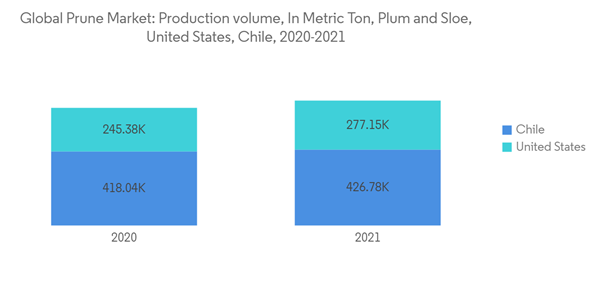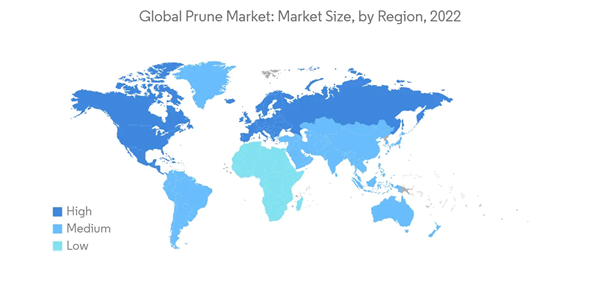Key Highlights
- Prunes are dried plums. According to data from the Office of Agrarian Studies and Policies (Odepa), Chile exported a total of 67,000 mt of prunes worth USD 256 million in 2022, with the main buyers being China (11,582 mt), Mexico (6,677 mt), and the United Kingdom (5,295 mt). In total, 81 countries received this dehydrated fruit. According to the Food and Agricultural Organization of the United Nations (FAO), globally, the United States accounts for 48% of world exports, followed by Chile (13 %) and France (12 %). France exports roughly 40% of its total production, and Chile exports as much as 90% (FAS).
- The global prune consumption peaked and is expected to register promising CAGR, primarily due to the changing consumption patterns across economically well-developed nations. Nowadays, people are more concerned about their health and shifting toward a healthy diet. Prunes are primarily made up of carbohydrates and are beneficial in managing several health conditions like constipation. It reduces bone loss and supports weight loss. It also improves heart health and prevents premature aging.
- As per the statistics revealed by the International Nuts and Dry Fruit Council, the United States was the largest consumer of prunes, followed by France, the Russian Federation, and Brazil, respectively, due to health benefits. Prunes' health benefits and nutrient quality make them popular among people, thus increasing the demand for prunes globally. The health benefits of prunes and the rising prominence of vegan diets are likely to accelerate the prune demand over the forecast period.
Prunes Market Trends
Health Benefits and Nutrient Quantity
A prune is a dry plum, most commonly the European plum. People are more concerned about their health and inclined toward a healthy diet. Prunes are beneficial in the management of several health conditions like constipation. It reduces bone loss and supports weight loss. It also improves heart health and prevents premature aging. Prunes are rich in antioxidants, which help reduce inflammation and protect cells from damage. Prunes have low sugar content than other dried fruits. Contrary to the belief that fruit rich in carbs increases blood sugar levels, prunes do not cause a sudden spike in the blood sugar level. One prune provides 1 gram of fiber and 3% of the daily fiber intake. There are a little over 6 grams of carbohydrates in one prune.Prunes are a great source of beta carotene, which the body converts to vitamins A, B, and K, potassium, zinc, iron, calcium, magnesium, manganese, and copper. They can be pitted and eaten whole or used to improve processed foods. Prunes garnered nearly 13.5% share in the global dry fruit consumption across high-income economies countries. Countries like the United States, Chile, Algeria, Brazil and others can produce prunes. Chile can produce 100,000 mt of plums, of which 2/3 are used for prunes, which, after the drying process, are sent to a subsequent tenderization process after their natural condition. Thus, the health benefits of prunes are gaining traction globally, which is expected to boost the market during the forecast period.
The United States May Dominate the Prunes Market
The United States is among the world's largest producers and consumers of prunes. Although the country exports significantly, it buys prunes from Chile due to high domestic demand. According to ITC Trade Map, in 2021, the United States was among the top exporter of prunes in the world. The export value of prunes from the United States was observed at USD 175,715, which was higher than in 2020, at USD 159,680. According to the Food and Agricultural Organization of the United Nations (FAO), globally, the United States accounts for 48% of world exports, followed by Chile (13 %) and France (12 %). France exports roughly 40% of its total production, while Chile exports as much as 90%.Prunes are on the list of the most highly consumed dried fruit in the United States, after dates. In the United States, schools have been focusing on healthier options for their students and are buying more locally sourced food. Dried plums are a great option for foodservice operators to introduce into schools. They can be pitted and eaten whole or used to improve processed foods. The growing urge for healthy eating habits across millennial groups in the United States reveals the increasing consumption pattern in the US market. Thus, driven by the marketing campaigns and the excessive supply in the domestic market, the prune production and export trend will likely get boosted in the US market over the coming years.
Additional Benefits:
- The market estimate (ME) sheet in Excel format
- 3 months of analyst support
This product will be delivered within 2 business days.










